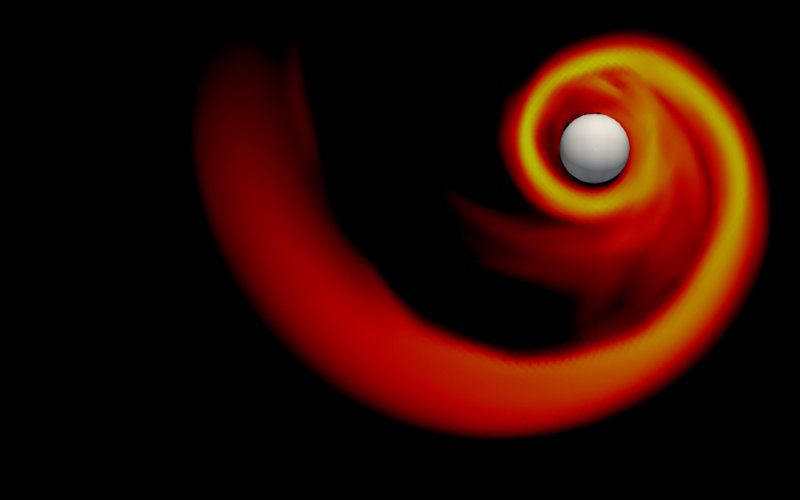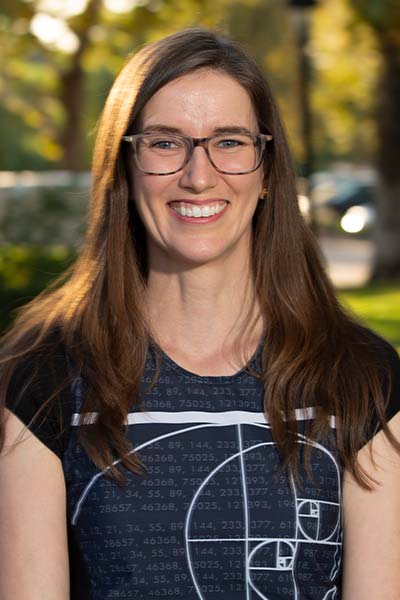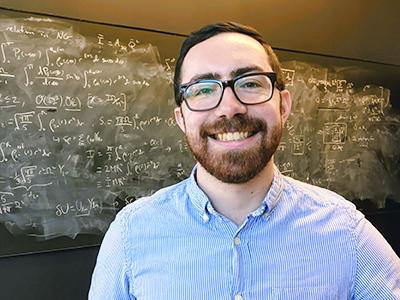
For the first time, gravitational-wave scientists have detected two collisions between a black hole and a neutron star, with Cal State Fullerton researchers involved in interpreting the novel cosmic events.
The extreme mergers made splashes in space that sent gravitational waves rippling across at least 900 million light-years to reach Earth. In each case, the neutron star was likely swallowed whole by its black hole partner.
Contributing to this discovery are Cal State Fullerton’s Jocelyn Read, associate professor of physics, postdoctoral research associate Philippe Landry and physics graduate student Derek White ’20 (B.S. physics), all of the Nicholas and Lee Begovich Center for Gravitational-Wave Physics and Astronomy (GWPAC).
The physicists are co-authors of the scientific journal paper published today (June 29) in The Astrophysical Journal Letters and made contributions to the analysis of the data.

“Observing this new category of gravitational-wave sources tells astronomers about the cosmic history of the massive stars that are needed to produce neutron stars or black holes,” said Read, an astrophysicist. “We have the first estimates of how often these collisions occur and how much events like this might contribute to the formation of heavy elements in our universe’s history.”
This latest discovery was announced by the National Science Foundation’s Laser Interferometer Gravitational-Wave Observatory (LIGO) in the United States and by the Virgo detector in Italy. The KAGRA detector in Japan, which joined the LIGO-Virgo network in 2020, was not online during these detections.
Scientists observed two black-hole-neutron star events occurring just 10 days apart in January 2020. The first merger, detected on Jan. 5 involved a black hole about nine times the mass of our sun, or nine solar masses, and a 1.9-solar-mass neutron star. The second merger was detected on Jan. 15, and involved a six-solar-mass black hole and a 1.5-solar-mass neutron star. Black holes and neutron stars are the corpses of massive stars, with neutron stars limited to at most a few times the mass of the sun, Read explained.
Landry has been a leader in developing the LIGO-Virgo-KAGRA collaboration’s methods for carefully assessing whether the lower-mass stars should be interpreted as neutron stars.

“Usually we rely on light or tidal effects to identify neutron stars,” he said. “In this case, we only had the masses to go on. Fortunately, they fit comfortably in the range we expect for neutron stars, so we’re pretty confident about the identification.”
The CSUF team worked to support and validate the calculation that determined how much matter would be flung out from these systems, or, as it turns out, would not be flung out, to glow in light, Read said.
“That also limits how much these particular events would contribute to distributing heavy elements like gold through their host galaxies,” she added.
Astronomers were alerted to both events soon after they were detected in gravitational waves — ripples in space-time — and subsequently searched the skies for associated flashes of light, but none were found.
“This is not surprising due to the very large distance to these mergers, which means that any light coming from them, no matter what the wavelength, would be very dim and hard to detect,” Read explained.
The mergers likely did not emit any light in the first place because their black holes were significantly bigger than their neutron stars, Landry noted.
“The collaboration determined that practically all of the neutron star matter was eaten by the black hole in one bite, leaving no leftovers to power the light show that telescopes looked for — so, no fireworks this time,” he said.
Previously, the LIGO-Virgo network found two other candidate neutron star-black hole mergers. One event called GW190814, detected Aug. 14, 2019, involved a collision of a 23-solar-mass black hole with an object of about 2.6 solar masses, which could be either the heaviest known neutron star or the lightest known black hole.
The first gravitational wave discovery from merging black holes was in 2015 and announced in 2016, which confirmed a major prediction of Albert Einstein’s 1915 general theory of relativity and led to the 2017 Nobel Prize in Physics. Since then, scientists, including CSUF researchers, have identified more than 50 gravitational-wave signals from the merging of pairs of black holes and of pairs of neutron stars.
Read and Landry will continue to work on what scientists can learn about neutron stars from these new discoveries.
“We’ve seen gravitational waves from two neutron stars crashing together before, but these observations have given us a new kind of neutron-star binary to explore. And this time, thanks to work by Dr. Landry and his collaborators, we’re confident there were neutron stars in these sources,” Read said.